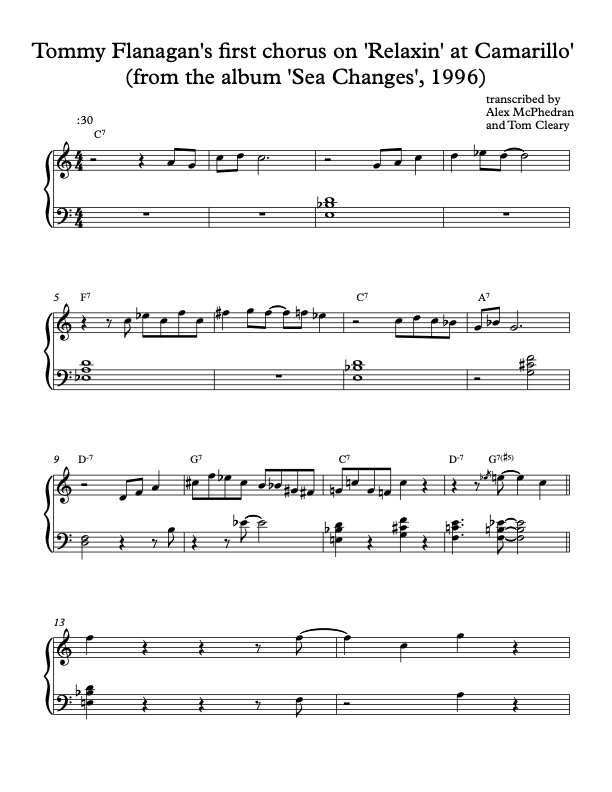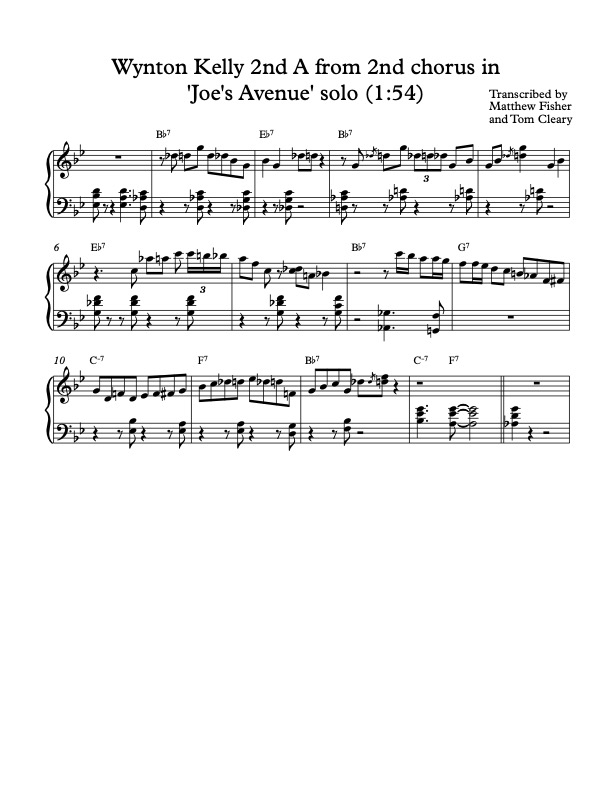In a Keyboard Magazine article from 2011, George Colligan uses the term ‘hand-to-hand conversation’ to describe an aspect of Horace Silver’s style on piano. He demonstrates this with an example from Silver’s solo on ‘Cape Verdean Blues‘ where Silver alternates between right hand melodic lines and left hand chords, mirroring the phrase structure of the head. While I encourage you to listen to the original recording via the link in the last sentence, the specific example from the article can be heard by clicking on ‘EX. 2’ at a Soundcloud page of examples from the article.
I have found that hand-to-hand conversation (which I also call ‘dialogic phrasing’) is a crucial skill for jazz pianists that is often overlooked in discussions of jazz piano techniques. I have heard both Marcus Roberts and Mulgrew Miller mention in workshops with students that is important to find ways to not always play with both hands simultaneously, and more recently I read comments from adjudicator who, along with a good deal of otherwise positive feedback, advised a talented auditioning jazz pianist to ‘decouple’ the hands when taking a solo. I think it is helpful to add that piano is one of the few instruments in jazz (other than drum set) where listeners can hear the distinct sound each hand makes, and hear these different sounds as being in conversation with each other. Thus, while there are many important hands-together techniques that jazz pianists need to learn, it is also important to learn the skill of hand-to-hand conversation.
In developing technique, pianists have to contend with a number of kinds of physical inequality present in the human anatomy. There is a natural inequality of fingers: the first, second and third fingers are naturally more independent than the fourth and fifth. Pianists often practice exercises to work toward increasing the independence of the fingers that are naturally the least independent. Also, pianists who are not naturally ambidextrous – which is to say most pianists – begin their studies of the instrument with one ‘weak’ hand that is naturally less agile than the ‘strong’ hand.
The various piano-playing styles that can be seen in different jazz eras, and among different jazz players in the same era, can be seen as differing responses to the natural inequality of a ‘weak’ left hand and a ‘strong’ right hand. Stride pianists gave the left hand a role that is at least equally challenging to that of the right (and sometimes more challenging) by combining the role of the bass and chord instruments into one limb. In the small group playing of pianists like Bud Powell and Thelonious Monk, the left hand begins to occupy a middle ground between the range of the walking bass line (generally below D3 on the piano) and the melody. These players often used two note ‘shell’ voicings that combine a root or 5th on the bottom with one other chord tone, usually the 7th or 3rd, on top. Sometimes these voicings were expanded to ‘compound tenths’ in which one more chord tone was added, for instance the third above a root-seventh shell. (For more on this style, see my transcription of his solo on ‘Buzzy’ in my post about the influence of his playing on Wynton Kelly’s.) Although some of these players (particularly Monk) played in a stride style as well when playing solo, the newer approach to chord voicing led to improvised solos where the right hand played a more active and chromatic line, mirroring the lines improvised by horn players in the bop era, and the left hand was often much less active than a stride player’s left hand, leaving to bass players, guitarists and drummers the role of being the tune’s metronomic heartbeat.
Sometime in the early to mid 1950s, jazz pianists, I would argue under the influence of players like Erroll Garner, began to move their chord voicings slightly higher in the left hand range of the piano, build them in smaller intervals, and began to alternate root position voicings with ‘rootless’ voicings that combine the two essential notes (the 3rd and the 7th) with one or two additional notes, often ‘upper structure’ notes like 9ths, 11ths and 13ths. Red Garland and Bill Evans, playing in Miles Davis’s mid-century small groups, were among the first and most prominent players to adopt this style of chord voicing, while taking a more sparse rhythmic approach to chord playing than Garner, who often played his close-harmony voicings in insistent quarter notes.
The solo transcriptions below are collaborations with three of my UVM jazz piano students, Alex McPhedran, Harry Woodward and Matthew Fisher. We transcribed solos by two players, Tommy Flanagan and Wynton Kelly, who were slightly younger than Evans and Garland. Kelly took over the piano chair in Davis’s band when Davis abruptly fired Garland, and Kelly alternated with Evans for a time in that chair. Their best known game of musical chairs is the album ‘Kind of Blue’, where Evans plays on most of the tunes and Kelly plays on ‘Freddie Freeloader’, taking a notable and iconic piano solo which is arguably better known and more influential than any of Evans’s solos on the album. Although Flanagan did some brief and little-known recording work with Davis, his better-known earlier recorded work includes trio albums like Overseas and albums like ‘Jazz Lab’ by Donald Byrd and Gigi Gryce and ‘Incredible Jazz Guitar’ by Wes Montgomery. Both Kelly and Flanagan’s left hand approach featured mostly the higher voicings heard in the left hands of Garner, Garland and Evans with occasional use of the lower shell voicings that were so prominent in the improvising of Monk and Powell. In the solos below, Flanagan and Kelly also occasionally break the higher voicings down to two note ‘guide tone’ voicings (often just the 3rd and 7th), or sometimes just a single note.
In contrast to the Horace Silver excerpt cited by Colligan, where right-hand melody ‘questions’ or ‘calls’ are followed with left-hand chordal ‘answers’, Flanagan and Kelly carry on a hand-to-hand conversation with left hand chordal ‘questions’ and the right-hand melodic ‘answers’. While the left hand sometimes continues comping underneath the right hand ‘answers’, I think it is also useful to practice these solos with the entire right hand line but only the left-hand chording that happens in the breaks of the right hand lines. This facilitates playing the solos (simplifying is often a good initial practice strategy) and also emphasizes the dialogic nature of the solos.
On his recording of Charlie Parker’s ‘Relaxin’ at Camarillo’ from the 1996 album ‘Sea Changes’, Tommy Flanagan opens his solo with a series of two-bar phrases where left hand changes on the downbeat are followed by short, spacious right hand phrases. It is interesting to contrast this opening to the opening of Flanagan’s solo on ‘Relaxin” from the trio album ‘Overseas‘, recorded nearly forty years earlier in 1957, where Elvin Jones’s energetic brush work inspires a more dense right hand line from the younger Flanagan. While in his 1957 version Flanagan finds hand-to-hand conversation later in the solo, in his 1996 version, despite playing with the equally energetic support of Lewis Nash on drums and Peter Washington on bass, he had the courage to begin by leaving enough space to make an inner dialogue audible.

The 1961 Miles Davis album ‘Someday My Prince Will Come’ is from a transitional period between his ‘first quintet’ with Red Garland on piano that is heard on four of his iconic ‘apostrophe’ albums (Cookin’, Relaxin’, Workin’ and Steamin’ with the Miles Davis Quintet, all released between 1957 and 1961) and his ‘second quintet’ with Herbie Hancock on piano that first appears on the album ‘E.S.P.’ in 1965. On his first solo from the F blues ‘Pfrancing’, shown below in a transcription by Harry Woodward and myself, Wynton Kelly uses a spacious approach that mirrors the increasing concision of Davis’ playing while still using bebop chromaticism such as that heard at measures 9 and 21-22. In an unusual move for a Davis small-group arrangement, Kelly solos at two other points in the recording, following Davis’ solo, when he echoes Davis’ use of a wider melodic range and ‘outside’ playing, and following Paul Chambers’s bass solo where he incorporates more double-timing. Where Davis and tenor saxophonist Hank Mobley stake out very different stylistic territories in their solos and seem not to be influenced by each other, Kelly is arguably the most responsive soloist on this recording, incorporating more ideas from his immediate surroundings than his bandmates.

In his solo on the shorter version of ‘Joe’s Avenue’, recorded in July 1960, Wynton Kelly arrives at a more dialogic approach in the second chorus of his solo on the AABA form of the tune (in which the A section is the twelve-bar blues progression in B flat). In a mysterious twist, the melody, harmony and form of ‘Joe’s Avenue’ is identical to that of the tune ‘Scotch and Water’, credited to pianist Joe Zawinul on a later recording by cornetist Nat Adderley with Zawinul (on the 1961 album ‘Naturally!’, which features Kelly appears on other tracks.) While the title ‘Joe’s Avenue’ sounds like a mishearing of ‘Joe Zawinul’ (in his opening monologue on the recording of Zawinul’s iconic Mercy, Mercy, Mercy, Cannonball Adderley pronounces the ‘w’ in Zawinul like a ‘v’), the fact that Kelly’s recording came first suggests that he could be the composer of the tune. In contrast to another available take of ‘Joe’s Avenue‘, where Kelly’s soloing becomes more ornate toward the end, on this shorter take, Kelly hits a conversational stride near the end of his solo, clearing out space at the beginnings of his right hand phrases so that his chords can clearly be heard as questions. Rather than more traditional solo trajectory of sparse to busy, Kelly increases his use of space later in the melodic story. (See below the transcription for more examples of this kind of solo.)

Other solo choruses that show players arriving at a greater use of space later in a solo include Miles Davis’ third chorus in his solo on Red Garland’s ‘Blues By Five’, Art Farmer’s third chorus on ‘Cool Struttin’ from the Sonny Clark album of the same name, Herbie Hancock’s third chorus on ‘Autumn Leaves’ from ‘Miles Davis in Europe’, Keith Jarrett’s third chorus on ‘Autumn Leaves’ from ‘Live At The Blue Note’, and Kelly’s solo on the version of Wes Montgomery’s ‘Four On Six’ from ‘Smokin’ at the Half Note’. In contrast to Flanagan’s more right-hand-heavy solo on ‘Four On Six’ from the version on ‘Incredible Jazz Guitar’, on ‘Smokin’ at the Half Note’ Kelly builds his solo toward a second chorus where he uses hand-to-hand conversation on the quick ii-V changes in Montgomery’s progression, which is built on the chord progression to George Gershwin’s ‘Summertime’, to which Montgomery adds number of passing chords.
this blog post copyright 2022 Tom Cleary
I just discovered your blog and it looks great! I will spend many hours reading all these posts. Note, I’m not a pianist, just a very amateur sax player – but certainly a jazz lover.